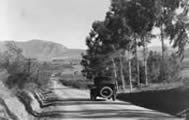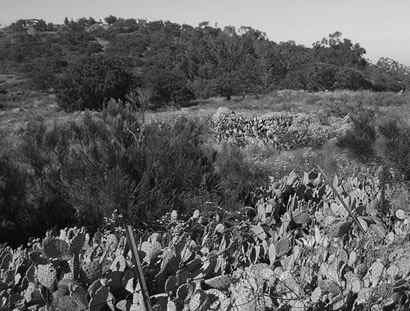|
View of Wright's Field, Alpine, California.
by Albert Simonson
If you want to know what is absolutely unique in Alpine, you need to take a tour of our Mesa del Arroz, right behind Joan MacQueen Middle School.
The old Spanish name was first shown on an 1846 map of the Alpine/ Viejas area, and appears in various old documents. It means “Grassy Mesa,” and to early rancheros like the Osuna brothers, sons of San Diego’s first mayor, grass and water were what you needed to raise cattle. In that hide-and-tallow economy, the surrounding brushy hills were worthless.
Some people just like the solitude of this big open space. Some appreciate that it is a rare so-called “California Native Grassland,” with rare plants such as were common when pronghorn antelope and bears wandered here, before Spaniards introduced European plant species. Flower enthusiasts like to search for the rare and beautiful chocolate lily, or mission bell.
I like it because it is a great place to bicycle, and because the historic beginnings of east county are still visible there upon the earth. The most notable of these is a long stone wall, enclosing about twenty acres of rock-free soil. The land just outside the wall is rocky.
Much of the stone for Alpine’s barbecue pits was stolen from this wall, now greatly diminished from the four-and-a-half-foot height evident in a 1928 photograph.
On the 1846 map this place is cross-hatched, which by mission and ranchero custom indicated a grain planting. And, indeed, the documentary record confirms that trains of Indian-led oxcarts passed from here on a tedious trail to San Diego’s army depot in 1853. Even without this knowledge, it is clear that only cultivation of grain would have been feasible on this heavy clay soil.
North of the grain field is a different kind of agrarian wall, built up of earth with stone facing, and very broad. Its top forms a nearly level line as the wall passes over sloping terrain, suggesting that it may have once supported an irrigation conduit, now vanished, probably of wood. Several other segments of stone wall exist on this land, but their purposes are less amenable to interpretation.
The Back Country Land Trust, owners and protectors of the land, have an excellent 1928 aerial photo which shows that little has changed in three-quarters of a century. The trees have grown somewhat, and the stone walls have been reduced in height.
We can probably blame much of the plundering on Ludwig Schmidt, who was reported by oldtimer Neil Galloway to have built many of the early fireplaces around here.
Ludwig, who also was known as Louis Smith, settled on this land March 13, 1888 and built his house. The foundation is still there, under a group of tall eucalyptus, in the northern part of the land which has been saved for public use. Next to it is a foundation to an adobe building which may date from earlier occupation.
At first glance, the grain field wall may appear to have been randomly piled up. Closer study shows it to have diagnostic characteristics of unusual width and a cobble core.
Kumeyaay natives left a number of stone wall remnants around Alpine, but this wall exhibits straight lines and arcs when seen from above. It may have been built by natives, but probably under mission or ranchero guidance. Prehispanic Indians had no need to protect grain crops from range cattle, but the introduction of European cattle put at risk most crops.
In the early 1840’s, the mission administrator was San Diego’s first mayor. His family came from Loreto, now in Baja California. His sons ended up owning the entire Alpine area in 1846. It will now perhaps not surprise you to find out that walls of this type are found around Loreto. Good specimens are found around Misión San Xavier, the best preserved stone mission church in the Californias.
These so-called “dry” (or unmortared) rounded-stone field walls are not known to exist anywhere else around here, but they are found in different parts of Latin America. Some even predate Spanish influence, such as a very similar wall around a funerary precinct at Ihuatzio in central Mexico. An oldtimer there explained to me that extremely heavy stones were manhandled into position with stone boats and levers.
England, and even New England, have dry walls of different configuration. They are protected by law and they contribute much to the charm of the countryside.
The discovery of Alpine’s field walls aroused great interest among academics in California. Not only is it apparently a rare relic of our Indian and Hispanic past, but the enormity of effort required for its construction amazes all who see it.
There must have been strong motivation to move so many tons of rock. One clue to motivation is that, before the early 1870’s, the law of the open range prevailed. Rancheros had no liability if their range cattle trampled or ate your crop, so you needed a fence around it. Another clue is that when the Osuna brothers petitioned the government for this land, the mission padre cited a need to “prevent incursions and rustling by gentiles [heathen Indians].”
Being strategically located at a narrow chokepoint in the open grassland corridor between brushy hills, the walls would have served both purposes perfectly. Traffic of men and cattle could have been controlled by vaqueros between the flanking heights.
With the passage of new fence laws and the invention of barbed wire, vaqueros were no longer needed to follow the herds. Most hung up their “chaparreras” (chaps) for a last time, said “adios” to a proud Spanish-Indian tradition and passed into history transmogrified into a John Wayne image. Now, no western museum is complete without a display board of the early barbed wire. That brought an end to an era.
So what is special about Alpine is that it shows how things were in the west before barbed wire, in the days of open rangeland.
Recently, members of the Alpine Historical Society were taken on one of the Back Country Land Trust’s regular tours of the land. The society’s president, Carol Morrison, probably summed up everyone’s feelings when she said that Alpine now has truly unique resources with which to promote tourism and education.
“We are all just astonished at how much the Back Country Land Trust has been able to accomplish for the benefit of the community,” she said. “I can see this land becoming a living classroom just behind the new school.”
|




